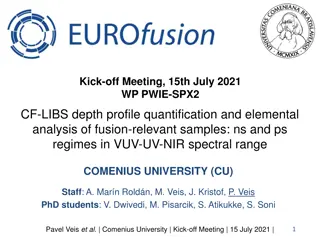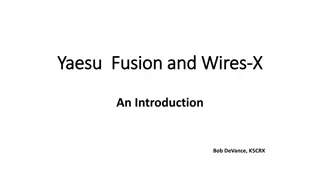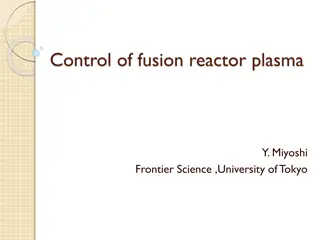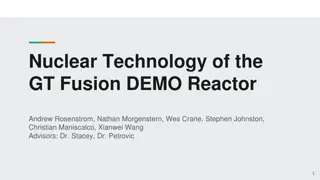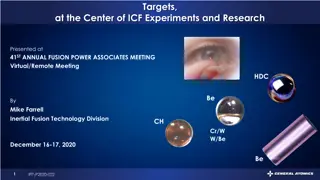Insights from 40 Years of Fusion Science & Technology Research by Mohamed Abdou
Mohamed Abdou, a distinguished professor, shared key lessons from four decades of fusion research. He highlighted scientific challenges, critical R&D areas, pathways to commercialization, and long-term project management complexities. The presentation mentioned three key references, including a comprehensive keynote and two major review articles. Abdou emphasized essential challenges and issues in fusion technology development that require focused R&D efforts for progress.
Download Presentation

Please find below an Image/Link to download the presentation.
The content on the website is provided AS IS for your information and personal use only. It may not be sold, licensed, or shared on other websites without obtaining consent from the author. Download presentation by click this link. If you encounter any issues during the download, it is possible that the publisher has removed the file from their server.
E N D
Presentation Transcript
Lessons Learned from 40 Years of Fusion Science and Technology Research Mohamed Abdou Distinguished Professor of Engineering and Applied Science Director, Fusion Science and Technology Center, UCLA With much appreciation to the many scientists and engineers I have worked with over decades! FPA Annual Meeting December 16-17, 2020 M. Abdou FPA Dec 2020 1
Lessons Learned from 40 Years of Fusion Science and Technology Research Since I was a student decades ago until now, I have been fortunate to have the opportunity to make fundamental contributions, lead key multi-institution and international studies and programs, and serve on many panels and committees So the key lessons I learned in 40 years are deep into - The scientific and engineering challenges - The most critical issues, and the most critical R&D yet to be done - The challenges of developing credible pathways to commercialization - The complexity of managing the very long-term fusion endeavor on government and community levels These lessons learned cannot be conveyed in this 12-min presentation. Therefore, I will only highlight 3 references: Comprehensive Keynote Presentation I made recently on the lessons learned TWO Major recent Review Articles that I wrote with other distinguished world experts and leaders in plasma physics and fusion technology 2 M. Abdou FPA Dec 2020
Ref 1 ISFNT-14 Keynote Mohamed Abdou "Lessons Learned from 40 Years of Fusion Science and Technology Research" Plenary Keynote Invited Presentation at the International Symposium on Fusion Nuclear Technology (ISFNT-14), Budapest, Hungary, September 22-27, 2019. Web link: http://www.fusion.ucla.edu/abdou/abdou%20presentations/20 19/MAbdou_ISFNT- 14_Keynote_Lessons_Learned_(2019).PDF M. Abdou FPA Dec 2020 3
Highlights of the ISFNT Keynote Key Challenges/Issues and Required R&D for which progress over the past decades has been frustratingly slow But must be confronted in any serious plan to develop fusion 1. Confinement Concepts (and their interplay with Fusion Nuclear Science and Technology FNST) High Power Density and High Temp. Operation/Economics Multiple Effects/Multiple Interactions RAMI (Reliability/Availability/Maintainability/Inspectability) Tritium Fuel Cycle and Tritium Self-Sufficiency External T Supply and Required T Startup Inventory Construction and operation of a facility in which the fusion nuclear components inside the vacuum vessel can be tested and developed in the true fusion nuclear environment (FNSF, VNS, CTF, or whatever you call it) 2. 3. 4. 5. 6. 7. M. Abdou FPA Dec 2020 4
Some key points from ISFNT Keynote RAMI is the Achilles Heel issue for fusion -- MTBF/MTTR will be the key issue in determining the feasibility of plasma confinement configurations and the feasibility of blanket concepts and material choices -- Performance, Design Margin, Failure Modes/Rates must be the focus of FNST R&D Not a long dpa life With current pathways toward DEMO, the anticipated MTBF is hours/days (required is years), and MTTR is 3-4 months (required is days), and availability is very low < 5% Fundamental Reasons: Complexity of configuration of current confinement concepts, necessity of locating Blanket/FW/Divertor inside the vacuum vessel We don t have a credible pathway yet to achieve the needed high power density Reasons: 1- estimates of achievable of ~ 2% in ITER and DEMO is much lower than the 10% estimated in the 1980 s, 2-Limitations on power handling capabilities of Current FW/Blanket/Divertor concepts The Need for High-Temperature Structural Material was realized early. But, after 40 years, the only viable structural material that fusion has now (ferritic steel) is limited to < 550 C and is very EXPENSIVE!! 5 M. Abdou FPA Dec 2020
Some key points from ISFNT Keynote (contd) FNST multiple effect phenomena cannot be synthesized from separate effects. UCLA simulations show that Spatial gradients in nuclear heating & temperature in LM blanket combined with ? and ? lead to New Phenomena that fundamentally alter our understanding of the MHD Thermofluid behavior, Tritium Transport, and Materials Interactions in the blanket in the fusion nuclear environment. Experiments on MaPLE-U at UCLA confirmed this discovery Results from separate effects over the past 30 years are misleading Multiple effects facilities & experiments are expensive, but are necessary for FNST to make progress In Fusion, a serious mistake gets repeated. We tend to be too ambitious in paper studies for DEMO (and Power reactors). We make many assumptions without key data from realistic simulations and experiments in the relevant environment. The result is that we cannot build them and fusion is taking very long. Obvious example: We never built or tested blanket. Yet paper design and pathway studies continue to design and quote performance not based on real relevant science/engineering data base. M. Abdou FPA Dec 2020 6
Some key points from ISFNT Keynote (contd) The key facility that must be built in the near-term is FNSF FNSF (or any name you call it) is a plasma-based facility to learn behavior of Blankets/FW/Divertor in the fusion nuclear environment, learn about multiple/synergistic- effects phenomena, quantify the potential to attain T self-sufficiency, and understand failure modes, rates, effects (RAMI). (and possibly produce excess tritium to supply the Required Start up inventory for DEMO) The requirements for FNSF were defined in FINESSE (1983-85) and refined in IEA HVPNS (1994-96): 1-2 MW/m2 with 10-20 m2 test area at FW. Only inside the vacuum vessel (FW/Blanket/divertor modules) need to be prototypical. Plasma can be highly driven We need to build sequentially the facilities that we can realistically build and get real data to make progress. Defining very ambitious facilities that look good on paper only delays fusion Learn the lesson: ITER is being constructed with the first DT plasma scheduled for 2036 57 years after the initiation of the design of an international burning plasma device. M. Abdou FPA Dec 2020 7
Ref 2 Comprehensive Review Article just Published this week in J. of Nuclear Fusion Mohamed Abdou, Marco Riva, Alice Ying, Christian Day, Alberto Loarte, L.R. Baylor, Paul Humrickhouse, Thomas F. Fuerst and Seungyon Cho Physics and technology considerations for the deuterium tritium fuel cycle and conditions for tritium fuel self sufficiency 2021 Nuclear Fusion 61 013001 Web link: https://iopscience.iop.org/article/10.1088/1741- 4326/abbf35 M. Abdou FPA Dec 2020 8
The Nuclear Fusion Article is a comprehensive review and analysis of the state-of-the art and required R&D for the physics and technology of the DT Cycle Co-authored by 7 experts and world leaders in plasma physics, fueling technology, tritium processing, blanket, and safety Comprehensive, 50 journal pages. Detailed Table of Contents helps readers navigate through the many complex topics. 194 references Topics and Sections of the Paper: 1. Description of the Fuel Cycle 2. Dynamic Fuel Cycle Models to determine time-dependent Tritium Flow Rates and Inventories, and perform Self-Sufficiency Analysis and Start-up Assessment 3. Tritium Inventories and Self-Sufficiency Analysis 4. Calculation of the Required Tritium Start-up Inventory and Assessment of the Availability of External Tritium Supply for Start-up of near- and long-term Fusion Facilities 5. Plasma Physics Aspects of the Tritium Burn Fraction and Predictions for ITER and Beyond 6. Plasma Fueling Technology and Predictions of Fueling Efficiency for ITER and DEMO Based on Experiments and Modelling 7. Tritium Safety 8. Options for Tritium Fuel Cycle Technology for DEMO and Required R&D M. Abdou FPA Dec 2020 9
Some key points from Nuclear Fusion T Paper Dynamics modeling analysis shows that the key parameters affecting tritium inventories, required start-up inventory, and tritium Self- Sufficiency are the: Tritium burn fraction in the plasma Plasma fueling efficiency Processing time of plasma exhaust Reactor Availability Factor Reserve Time needed in the storage system Doubling Time needed to create new startup inventory The physics and technology state-of-the-art will not enable DEMO and future power plants to satisfy the Principal Requirements of T self- sufficiency and Providing the initial start-up tritium inventory of a fusion facility. The paper defines specific areas, ideas, and goals for physics and technology R&D to meet these requirements. Successful outcome of this R&D cannot be assured. We hope the paper will stimulate new ideas and approaches. M. Abdou FPA Dec 2020 10
Some key points from Nuclear Fusion T Paper (contd) With ITER DT start in 2036, there will be no tritium left to provide Start up T inventory for any major DT Fusion facility beyond ITER. The world fusion programs cannot depend on external non-fusion supply of T to provide startup T inventory for 2 or 3 DEMOs plus other near-term facilities Therefore, Fusion Development Pathway must develop a strategy that confronts this problem. Some key elements of such a strategy are presented in the paper, and some key findings are We show that the T burn fraction (TBF) in ITER with 50% DT mix is 0.36%, the fueling efficiency with shallow penetration in burning plasma (ITER, DEMO,..) is < 25%, and T processing time is a few hours. With such performance T self-sufficiency cannot be achieved, and the Required T startup inventory is huge. The paper describes important plasma physics, fueling technology and T processing innovative ideas for major improvements Linear dependency between the tritium start-up inventory and the fusion power suggest that near term fusion facilities should be designed for low fusion power (< 150 MW) in order to keep the required start-up inventory small and obtainable, i.e.< 1Kg The Need for much higher reliability and much faster maintainability in all components of the T fuel cycle beyond what is currently predictable is shown to be essential for the feasibility of the DT Cycle. (Again: RAMI is the Achilles Heel issue for fusion!!) - Results show strong dependence of the potential to attain self-sufficiency in fusion devices on the availability factor when it is lower than ~30% M. Abdou FPA Dec 2020 11
Ref 3 Major Review Article Published in Fusion Engineering and Design Mohamed Abdou, Neil B. Morley, Sergey Smolentsev, Alice Ying, Siegfried Malang, Arthur Rowcliffe, Mike Ulrickson, Blanket/first wall challenges and required R&D on the pathway to DEMO", Fusion Engineering and Design 100 (2015) 2-43. Web link: http://www.sciencedirect.com/science/article/pii/S092037961 5302465 M. Abdou FPA Dec 2020 12
Highlights of the Fusion Engineering and Design Paper Comprehensive Review and Detailed Analysis by world experts Long 43 journal pages. Detailed Table of Contents helps readers navigate through the many complex topics 154 detailed references Intended for both senior program leaders and young scientists and engineers Examples of topics analyzed: DEMO definition and primary world blanket concepts Detailed Presentation of Key technical Issues Challenges in developing blankets and implications for the R&D pathway Science-based framework to advance R&D and measure progress R&D in non-fusion facilities R&D in fusion facilities M. Abdou FPA Dec 2020 13
Fusion Development spans human generations Therefore, it is particularly important that the world fusion community ensures proper documentation of all R&D, design and pathways studies, etc. At UCLA, we are doing our share on this. Our website www.fusion.ucla.edu has all publications and presentations, reports from major studies we led PLUS special section for scans of all major studies in the 1980 s that cannot be repeated today (e.g. BCSS, FINESSE, DEMO, IEA- VNS, ) Many organizations are doing the same. I encourage all organizations, scientists and engineers to pay attentions to documentation I am concerned about the current situation with the documentation of the ITER activities. ITER IO policy makes it very difficult for scientists and engineers to publish. As Editor-in-Chief of a major scholarly journal, I see the frustration of scientists and engineers in IO and around the world of not being able to publish scholarly articles, or even reference ITER reports. Major benefits can be drawn from learning what the technical/engineering problems are, solutions considered, and why a certain solution was preferred. ITER IO should be encouraged to relax publication policy. M. Abdou FPA Dec 2020 14
Concluding Remarks The pace of fusion development has been too slow. Regardless of the reasons for this, the negative effects on the perception of fusion outside the community and the confidence and enthusiasm inside the community are obvious. We can not continue to talk about issues we know how to solve and ignore critical go/no-go problems that we don t know yet how to solve. It is time for all of us to bring in ingenuity, experience, determination, and honest critical thinking, and to ask for a more effective, more agile management and leadership, to develop a credible strategy for solving them and begin serious implementation at a much faster pace than over these past 40 years. 15 M. Abdou FPA Dec 2020
Thank you! 16 M. Abdou FPA Dec 2020









